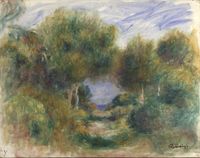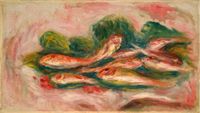Pierre-Auguste Renoir was born on February 25, 1841, in Limoges, France. His father was a tailor and his mother was a dressmaker. In 1845his family moved to Paris and settled near the Louvre Museum. There young Renoir had his first experience with art. From age 13 he became an apprentice painter in a porcelain factory, where he painted for five years. At age 19 he took drawing lessons from Charles Gleyre, and in 1862 he attended the Ecole des Beaux-Arts, a classical school of fine arts in Paris. There he met Claude Monet, Alfred Sisley, and Frederic Bazille, the future founders of Impressionism. During the 1860's Renoir was still painting in the academic tradition, and his portrait of his mistress, Lise Trehot, was traditional enough to be accepted at the 1867 Salon. In 1869 Renoir moved in with 'Claude Monet' and Frederic Bazille. Under their influence he updated his technique andcolor scheme. He started using little brush-strokes and vibrant pure colors while painting mainly outdoors, 'en plein aire'. In 1874 Renoir took part in the first exhibition of the 'Society of independentartists' in the Paris studio of photographer Nadar. Monet's painting 'Impression, soleil levant' (Impression, Sunrise 1872) was untitled until the first show in 1874. A title was needed in a hurry for the catalogue. Monet suggested 'Impression' as a simple title for his painting. The catalogue editor, Renoir's brother Edouard, added an explanatory 'Sunrise', thus making Impression: soleil levant the official title for Monet's work. From the painting's title, art critic Louis Leroy coined the term 'Impressionism', which he intended to be derogatory. Monet's title came under criticism which seized upon the first word. Renoir with Claude Monet, Camille Pissarro, Alfred Sisley, were joined by Edgar Degas, and Georges Seurat, and continued to exhibit together despite the financial failure of the first show. Impressionists slowly gained recognition after 1880, when public begun to recognise the value of their works. In 1881 Renoir traveled to Algeria, then to Spain, and later to Italy to see masterpieces of Titian and Raphael in Florence and Rome. In 1882 Renoir met composer Richard Wagner at his home in Sicily, and painted his portrait. In 1883 he had his first one-man exhibition at the Paris gallery of Paul Durand-Ruel, who became his art dealer. He received commissions to paint portraits of prominent Parisians, and also made several group portraits of his friends, models, writers, and fellow artists, such as the 'Luncheon of the Boating Party' (1881). In 1887, being already famous, Renoir donated several paintings to Queen Victoria on her Golden Jubilee. At that time he worked on a big composition Les baigneuses (The Bathers), for which he made a series of nude female studies representing feminine grace with masterful depiction of the soft forms and tender texture of skin. His lively, joyful paintings brought him fame and steady success. In 1880 Renoir met Aline Chairgot. She became his model and a painting assistant. In 1885, their first son, Pierre Renoir, was born. They married in 1890, and spent much time in Essoyes, the childhood home of his wife. In 1894, while living in Montmartre in Paris, they had their second son, named Jean Renoir, who later became a famous filmmaker. His third son, Claude Renoir, was born in 1901. Family life was beneficial to Renoir's work. He became as interested in painting people as he was in painting landscapes. By the age of 50 Renoir became wealthy and famous, but his health declined. During the 1890s he developed rheumatoid arthritis and had to move to a warmer climate in the South ofFrance. In 1907 he bought a farm at Cagnes-sur-Mer. There Renoir expanded the garden into a beautifully landscaped park and continued painting landscapes and nudes. Renoir suffered from complications of arthritis and was wheelchair-bound during the last 20 years of his life. He also suffered from cataracts, which affected his vision so that his later paintings had a general reddish tone and softer lines. He continued to paint with a brush on a stick strapped to his arm, because he lost mobility in his fingers and in his right shoulder due to ankylosis. Renoir did not give up art, he even started making sculptures with an assistant. He died at his house in Cagnes on December3, 1919, and was laid to rest at the Cagnes-sur-Mer church cemetery. In 1962 his son Jean Renoir wrote 'Renoir My Father', the definitive biography of August Renoir.









